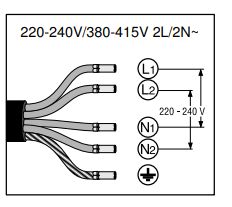Hello.
I have a three-phase connection at home, but unfortunately the 3-phase cable has not been pulled up to the kitchen. There are, however, two separate 1-phase cables:
- one 3x2.5 mm2 cable for a dishwasher, which I do not have - in the switchboard it is protected with a B16 fuse and a 25A differential on one strip
- the second 3x2.5 mm2 cable currently used to connect the refrigerator - in the switching station it is protected with a B16 fuse and a 25A differential on the second strip
Now the question.
Do I understand correctly that I can connect the induction hob according to the diagram as shown in the attached picture?

I connect L1, N1 and ground to one cable, and L2, N2 to the other.
Will such a connection be correct and "in line with the art", and will the board be able to use the full power of 7.4 kV?
An authorized electrician will be connected, but the possible possibility of such a connection has an influence on the choice of the plate model.
I have a three-phase connection at home, but unfortunately the 3-phase cable has not been pulled up to the kitchen. There are, however, two separate 1-phase cables:
- one 3x2.5 mm2 cable for a dishwasher, which I do not have - in the switchboard it is protected with a B16 fuse and a 25A differential on one strip
- the second 3x2.5 mm2 cable currently used to connect the refrigerator - in the switching station it is protected with a B16 fuse and a 25A differential on the second strip
Now the question.
Do I understand correctly that I can connect the induction hob according to the diagram as shown in the attached picture?

I connect L1, N1 and ground to one cable, and L2, N2 to the other.
Will such a connection be correct and "in line with the art", and will the board be able to use the full power of 7.4 kV?
An authorized electrician will be connected, but the possible possibility of such a connection has an influence on the choice of the plate model.






